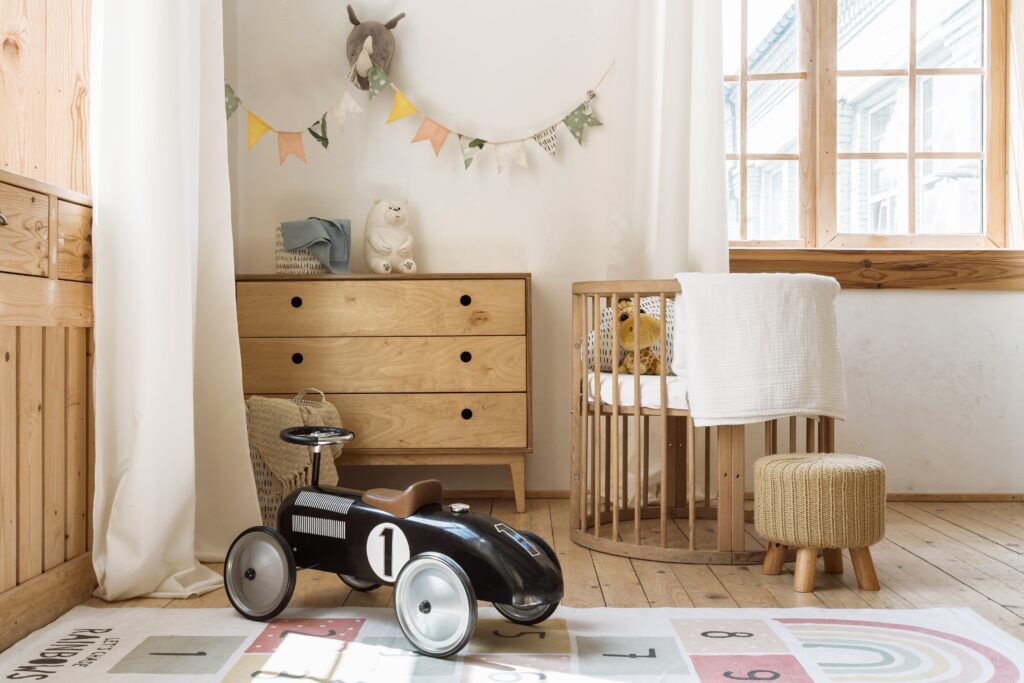I know what you’re going to say: This will never work – my kids refuse to throw away anything! And I know where you’re coming from. They all LOVE that broken plastic whistle they got in a party bag. Or LOVE LOVE LOVE that cuddly toy that has been shoved at the back of the cupboard for 6 months and not missed once!
This is why we all secretly chuck out the broken tat and outgrown clothes when they’re at school or asleep. And yes, sometimes they have a meltdown when they realise things have gone, but what else can you do?
LESS IS MORE
As impossible as it sounds, helping your kids to declutter their own things and work out what they want to keep and what they no longer need is teaching them something that will serve them well. It’s not about having so few things that the house can be IG-ready at all times, it’s about only keeping the things that you love or can use, and freeing up space in your house and your head.
Just like adults, kids get stressed by the overstimulation of “things”. By reducing the amount of toys (and clothes/books etc) that your child has, you’re reducing the amount of stimulation they they’re exposed to. Additionally, the fewer toys they have, the more opportunities your kid has for using their imagination and creativity, so it’s win-win!
Both decluttering and imaginative play are skills, and the more they do them, the easier they get, so take a look at these tips for decluttering with kids, and let’s get cracking!
“Both decluttering and imaginative play are skills, and the more they do them, the easier they get.”

LEAD BY EXAMPLE
Before you can expect the children to part with their stuff, you need to show them that the rules apply to you too. Set aside some time to declutter your own things, and make sure you involve them. As you’re sorting, talk to them about the decisions you’re making to keep or not keep. Talk about how much room you have in your home, how you like to live, and the problems caused by too much. Talk about what you do with the things you’re getting rid of. If they see you doing this regularly, they’ll absorb it, and it’ll just become part of what your family does.
- Keep an open mind
Remember that if you’re going to get your kid’s buy-in with this, you have to be patient and keep an open mind. Kids, especially little ones, have so little control in their lives, it’s no wonder they cling on fiercely to the few things that are theirs. Whilst you might see little point in that broken fire engine, if your child decides that they love it, but are willing to get rid of other things, it’s a win. It’s their stuff, so they make the decisions. - Little and often
It’s much better to get them to sort through one box or a drawer every now and then, rather than demand that they clear out their whole bedroom at once. Whilst it’s frustrating to take it slowly sometimes, you already know about the benefits of decluttering, whereas they still need to be taught them. So it’s small steps and repetition, repetition, repetition! - Start with the easy things
I’d recommend clothes. Yes, they might want to hang on to a few things that they love, even if they’re a bit tatty or don’t really fit any more, but for the most part, it’s an obvious step to get rid of anything they’ve out-grown or is worn beyond repair. Once you’ve discovered that they only have 3 respectable t-shirts and 2 pairs of trousers without holes, the promise of a few new clothes is often a good reward for their hard work! - Like with like
Decluttering toys by category is by far the easiest way to make sure nothing gets forgotten. Group together the puzzles (keep an eye out for ones that are missing pieces!), or the vehicles, or the toy babies and go through them by category. When you have similar things side by side, it’s much easier to make choices. Keep the categories broad though. Grouping all Character Toys together, for example, is a lot simpler than having a pile of Paw Patrol, a pile of action figures, and a pile of Hatchimals. And I bet the kids don’t separate them by brand when they play anyway – Spiderman is just as keen for a ride on the Paw Patrol Air Patroller, as Chase and Rubble (apologies if you don’t have a Paw Patrol fan, but you get the gist!).
(This tip goes hand in hand with number 6…) - Teach them about containers
You’re decluttering because the things you have in your home don’t fit in the containers you have for them, whether that’s a box, a cupboard or a room. Kids need to understand this. The space in your house isn’t limitless, and is shared with the whole family, so their toys, clothes and books can’t take up more space then is allocated to them. Yes, things can drift around during the day, but the point is that everything has a home that it can be returned to, when it’s time to tidy up, and that is what determines how much stuff you all get to keep (and don’t feel guilty – remember the less is more point above!).So breakdown their space into containers. For example, you have grouped together the puzzles. Pick a cupboard/shelf/box to store them in and that becomes the puzzle container, so you can only keep what fits in that container. Explain this to them, and get them to pick their favourite puzzle. In it goes. Then the next favourite and the next favourite. Once the container is full, they can decide if they want to swap anything, but from that point on it’s a one in, one out rule. They will inevitably find this difficult (we all do!), but remember, they are the ones making the decisions and the more they practice, and the more they see you doing it yourself, the easier it will be.They’re already probably doing it with their clothes. They might have a wardrobe and/or chest of drawers, for their clothes, but I bet they don’t have random piles of clothes around the house that wouldn’t fit in those containers if they were inclined to actually put them all away.
And then you just have to keep on going. Set aside a little time every now and then to move on to the next group of things and the next container.
“Slowly slowly, they’ll reduce what they have to only the things they want.”
Try to make it a regular practice, so every month or so, you take a look together and check in on the containers. There will be times when they regret decisions, and they wish they’d kept something, but try to keep it in perspective – 99% of their decisions will be done and dusted and never thought about again!

A NOTE ABOUT PRESENTS AND WASTE
It can feel wasteful to get rid of toys or clothes that you spent money on, or that were given to your children as gifts. It’s easy to feel guilty – it’s a veritable guilt party! There’s guilt at the thought of getting rid of things and guilt at the thought of things being unworn and unplayed with if you keep them.
You have to remember though that the money has already been paid and the thank you note has already been sent. We all make mistakes with what we buy and what we accept from friends (even big things), but remember it’s your home. You have to be there every day, and want to live in a way that is comfortable for you and doesn’t make you feel stressed. Holding on to things because of guilt, will only ever hold you back from this. So switch it round, and think of it as a positive. Through this process of decluttering, you have learnt about over-buying for your kids. You have learnt to say “no, thank you” to friends. You have learnt (and taught your children) to keep only what you value. Those are all good lessons!
Clothes and toys that are in good condition can be given to charity and other children will wear and play with them, so give yourself a break, let things go, and enjoy your home!



